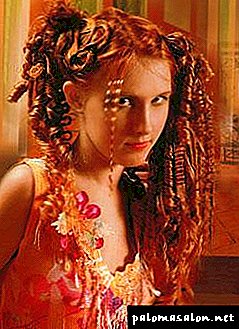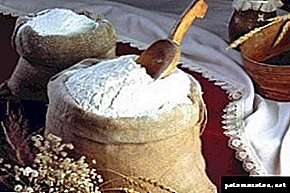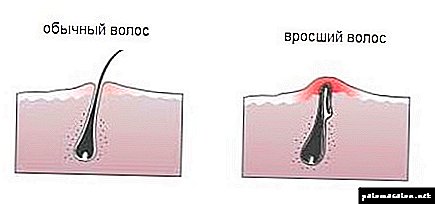Hair coloring: use more than harm.
 For eight months, I led a weekly column on hair coloring issues in the Sunday Times in London. During this time, I have consulted thirty-three women and three men. The idea to discuss the topic of hair coloring in the newspaper came to me because of the huge number of questions that I asked for many years.
For eight months, I led a weekly column on hair coloring issues in the Sunday Times in London. During this time, I have consulted thirty-three women and three men. The idea to discuss the topic of hair coloring in the newspaper came to me because of the huge number of questions that I asked for many years.
Most of the fears were due to the fact that the coloring contributes to hair loss, or their drying, or can give them fragility, or a bad effect on the scalp. In general, there is a generally accepted view that prolonged staining causes negative effects on the hair and scalp. This is not quite true.
I can state that hair coloring has an undeservedly bad reputation. I personally met with each client before and after dyeing and I can say that no one had increased hair loss. No one complained of dryness or brittleness that appeared (I insisted that they all follow the manufacturers instructions exactly and use the included air conditioner). In most cases, there was an improvement in the condition of the hair.
What really surprised me was that the condition of the scalp of those who had dandruff and / or itching improved. Of course, this was possible due to the antiseptic properties of coloring compositions, soft keratolytic (softening and removing dandruff) effect and thorough washing of the skin that accompanies coloring. But I certainly don’t encourage you to use dye to cleanse your skin or help your hair. Dyeing hair with modern means (especially in the case of painting gray hair) will help to gain psychological confidence, feel the renewal and its own significance. Nearly 70% of women and 12% of men dyed their hair at any time in their lives. For men, the figure may even be higher, as many of them do it in secret and never admit it.
Staining can be harmful only if you do not follow the instructions for use of the drug. For example, be sure to do preliminary tests for portability and perform preparatory activities recommended by the manufacturer.
Staining methods
I do not reject any method of staining. In fact, the opposite is true: the psychological effect of a change in hair color outweighs any possible damage. There are many ways to dye your hair, and the choice of colors is very large. Improved formulation formulas allow you to get wonderful shades, and the safety of paints is constantly monitored. I would especially like to note that the best result is achieved if you use the help of a specialist in coloring (or, as they say now, a colorist).
Natural dyes
Henna, chamomile, indigo and other herbs known to mankind for many thousands of years. When the Pharaohs were buried, their hair was dyed dark, so that they looked younger. The Romans used pasta made from powders and various soap-like substances of plant origin. Boiled and ground walnuts, soot, charred ant eggs, various berries and decayed animal remains - all used to hide gray hair or keep up with fashion. If we talk about modernity, then a few years ago there was a craze for henna - not only as a dye, but also as a therapeutic agent. This is certainly not a panacea, and as a paint, it is just one of many. Henna gives a non-natural shade of red, and the color distribution from the roots to the ends of the hair is uneven. The color fades quickly, and therefore staining requires repeated repetition. In addition, the shade of the sun can become orange, and when curling - ginger. Chamomile also gives a non-uniform color distribution, but due to the content of azulene it can reduce itching and soften the skin.
Tint shampoos (temporary dyeing)
This type of coloring affects only the surface of the hair. The paint is applied after each shampooing and is held until the next wash. The main drawback of these paints is the need to apply them after each wash, which discourages the desire to wash their hair often.
Is dead durable paints
durable paints
These paints are more durable - their effect lasts up to six months. They penetrate the hair cuticle, which protects them from washing out. The color of such dyes is closer to natural shades than the color of hue dyes, and they are simpler to use. Unlike durable (permanent) dyes, they are applied to wet washed hair, and the excess is then washed off. Their disadvantage is that they fade when you wash your hair and even just on the air and therefore require frequent application. The ends of the hair are usually darker than the roots, because they get more dye on them, and the natural look of the hair requires the opposite: the ends should be lighter than the roots due to the constant exposure to air and sun. As a result, the result can be very far from natural.
Some components of dyes may show increased sensitivity, so they are always advised to do a preliminary “patchwork” test in accordance with the attached instructions. This type of staining is mainly used at home. The test should be carried out before each application of paint (although many people think that if they have carried out this test at one time, they can continue to use this paint without repeating it). Unfortunately, for no apparent reason, allergies can occur between staining. Stress, changes in nutrition, the use of drugs, the environment - all of these factors increase the risk of sensitivity.
Permanent paints
These paints are known as oxidizing, because before dyeing it is necessary to mix the oxidant and ammonia solution with the actual dye. The composition of permanent dyes is very complex, and manufacturers make a lot of effort to achieve a quick effect and minimize disruption in the strength and elasticity of the hair. One of the main rules when creating paint - the safety of its application.
Plus dyes of this type is that they are used relatively rarely and therefore damage hair less. As for the harmful effects of paints of this type on the body, none of the many studies have not proved such harm. In addition, it is impossible not to take into account the enormous positive psychological effect that a new color of his hair has on a person.
Bleaching and lightening hair
The oxidative effects of these procedures discolor the pigment in the hair shaft, which makes the hair lighter. Most often, as before, hydrogen peroxide is a bleaching agent. Both this and other bleaching agents have a destructive effect on the hair proteins, making the hair dry, brittle and inelastic. Hair also becomes more porous, vulnerable to the action of the sun, water, wind, as well as other chemical processes (for example, when curling or straightening hair). The discoloration softens the skin, weakens the bonds between keratinocytes, so it is important not to rub the scalp too intensively when washing the bleaching agent, otherwise the skin will be chemically damaged.
If you do not use stabilizers, oxidizers quickly decompose. In addition, the discoloration occurs slowly, and to accelerate the process, oxidizing agents must be mixed with alkaline solutions immediately before use. Most often, ammonia is used as such a solution. Separately, hydrogen peroxide and ammonia are volatile, so it is difficult to keep track of each of them not getting on the already discolored area. That is why bleaching agents are used as emulsion creams with oils and waxes, and ammonia is added before applying the dye to the hair.
As a rule, a preliminary sensitivity test is not required for bleaching agents. They are rarely used by themselves, as they do not allow for natural shades. When used, the hair becomes straw-like and requires the addition of a variety of coloring agents in order for the hair to take on the desired shade.
Of all the known methods of dyeing, discoloration is potentially the most dangerous in terms of damage to the hair, so it should be entrusted to professionals. If you do it yourself, be very careful and carefully read the instructions.
Lightening hair strands, highlighting and silvering
These procedures are similar: small areas become discolored either by using a cap with small holes, where small tufts of hair are pulled, or by carefully separating the strands and applying paint on them with foil. This is a very effective way to shade gray hair or create the effect of sun-bleached hair. At the same time, only part of the hair becomes discolored and, due to mixing, the color lasts longer. This allows you to repeat this process less frequently, which makes it one of the safest staining methods. However, applying the composition to previously discolored strands creates problems due to additional damage to the hair cuticle.
Care for dyed hair
The process of dyeing hair in the salon includes the use of reducing compositions. If you dye your hair at home, you will also find an effective reducing agent in the package. This component is always required.
Any hair that has been dyed becomes vulnerable. The degree of damage depends on how many times you change color. The most dangerous transition from dark to light, because the coloring (bleaching) agent must be stronger. Any chemical process reduces the elasticity of the hair and increases their fragility. In addition to the reducing agent that you use immediately after dyeing, use a moisturizing conditioner a few days before and after dyeing. The same procedure should be carried out when bleaching.
It is very important to use conditioners after each washing of the head, as this helps to unravel the hair and nourish the hair cuticles damaged by alkaline solutions. Moisturizers should be chosen (for example, with natural oils) so that thin hair does not become too soft and unruly. Hair of any type can be beautifully combed and styled with styling products.
You should also avoid sharp combing of hair, rough towel wiping, too long drying with a hair dryer - especially hot, sharp pulling of hair, etc.
Straightening
This is a simple procedure in which wavy hair is straightened instead of curling straight hair: the solution is applied at the very roots, the hair is gradually pulled out with a special comb, and when the desired degree of straightness is achieved, use a fixative. Most often, this procedure is used for dark hair, and if you do not do it very carefully and carefully, you can seriously damage the hair. Hair straightening is required more often than curling - after about six to eight weeks. Thus, there is a significant risk to impose the effect of a new treatment on an old one.
It is best to straighten hair in the salon, where the process will be controlled by professionals.
Remember that minor factors may increase the speed of a chemical reaction: for example, a temperature increase in a room due to hot weather or heating systems. That is why careful control of the process is very important. This is another reason to do this with specialists.
So, professionals do not discourage us from dyeing and curling hair, which can be a huge support for our morale. They only indicate dangerous moments and try to warn us against severe traumatic injuries associated with discoloration and hairstyles in general.
If you do not wash your hair for two or three days with increased oily hair, the sebum decomposes under the influence of light and air and forms toxic products, the effect of which on the hair follicles is extremely unfavorable. Therefore, each person must develop for themselves the optimal mode of hygienic care, taking into account the individual parameters of the head and the hair texture.
The first wave rarely leads to serious problems. However, repeated can cause severe damage. The tips of the hair can be better protected by smearing them with fat, for example, with unsalted butter before applying the composition for curling.
Through the root perm method, only the roots or non-invisible parts of the hair are curled. However, this is quite a traumatic procedure, since it is difficult to avoid exposure to the previously curled hair and scalp.
It is necessary to care for hair with the help of conditioners. It is very important to intensively treat the hair with conditioner twice a week for two weeks before applying any procedure.
Never curl or straighten hair on the day of dyeing. It is best to wait a week, and first do the perm and then dye. For best results between curling and dyeing, condition your hair.
Avoid curling if your scalp is inflamed or damaged. If the skin becomes inflamed or irritated after curling, apply a solution of cold milk and water in equal proportions. This solution helps to soften and soothe the skin. If this does not help, consult a dermatologist.
Hair styling and straightening
Denis Ognev, stylist
Today, perm is not as popular as before. Curly hair, fashionable in the late 1970s, is now considered the "last century". Apparently, the reason is the appearance on the market of new effective tools for hair styling and styling. Over the past 10–15 years, it has become possible to create new compositions that strengthen the base of the hair and thicken it. One of the main goals that women over forty pursue when curling is to mask the changes inherent in age, by making the hair wavy and curly, to increase the thickness of the hair so that the hair looks voluminous.
The fundamental principle used in curling hair is elasticity. When hair is wet, it stretches out and swells, so that its deformation occurs - disulfide bonds are destroyed. When the hair dries, they return to their original shape. If the hair is twisted before it dries, it will acquire the shape offered to it, that is, it will become wavy or curly. Heat accelerates this process. The shape that hair gets will remain so until it is damp or wet. When curling with the help of a permanent, chemicals are used instead of water. This was first done by heating alkaline reagents, then in the 1940s a “cold” curl was proposed, in which the hair was moistened with a special solution, wound (the size of the curl depended on the size of the curlers), kept for a while and then “fixed” with the help of a neutralizing compound .
A characteristic feature of this method has become the availability and ease of use.It reached the peak of popularity when the “permanent for home use” appeared on the market, which allowed anyone who wanted to conduct the whole process at home.
The market for home-made permanent is much smaller, as preference is still given to professionals in salons. Due to the use of highly alkaline solutions, there is a possibility of serious damage to the hair, if you do not do it very carefully. Usually, ammonium thioglycollate is used as an alkaline solution for “loosening” disulfide bonds, and hydrogen peroxide is used as an oxidizing agent to fix the hairstyle.
The scalp reacts to the effects of chemical reagents in a similar way, so it can become sensitive and give painful effects after washing the curl composition.
With proper use of permed hair damage can be shined to a minimum. Meanwhile, if you leave the solution on the hair for too long, you can use neutralizing solutions too tightly or not very skillfully to use neutralizing solutions, problems may arise.



